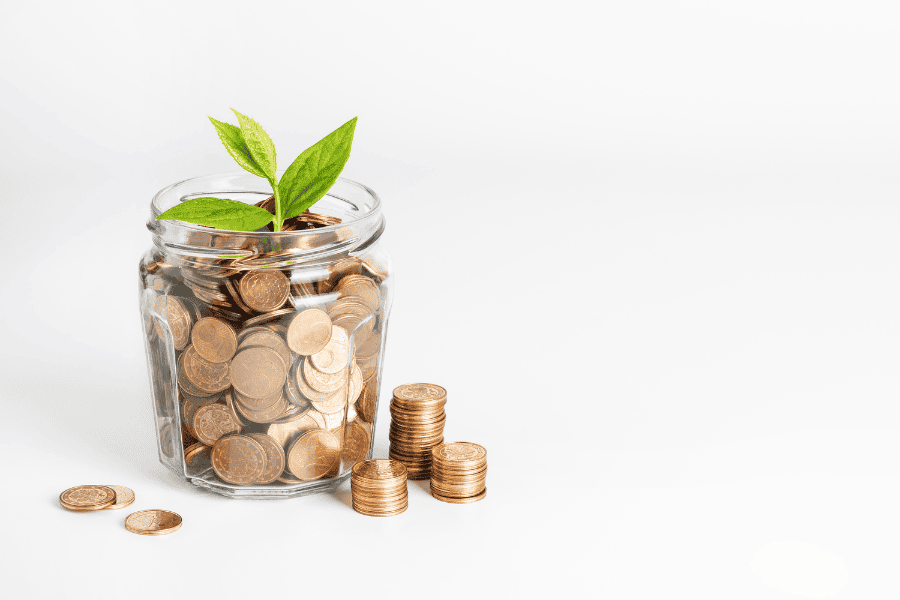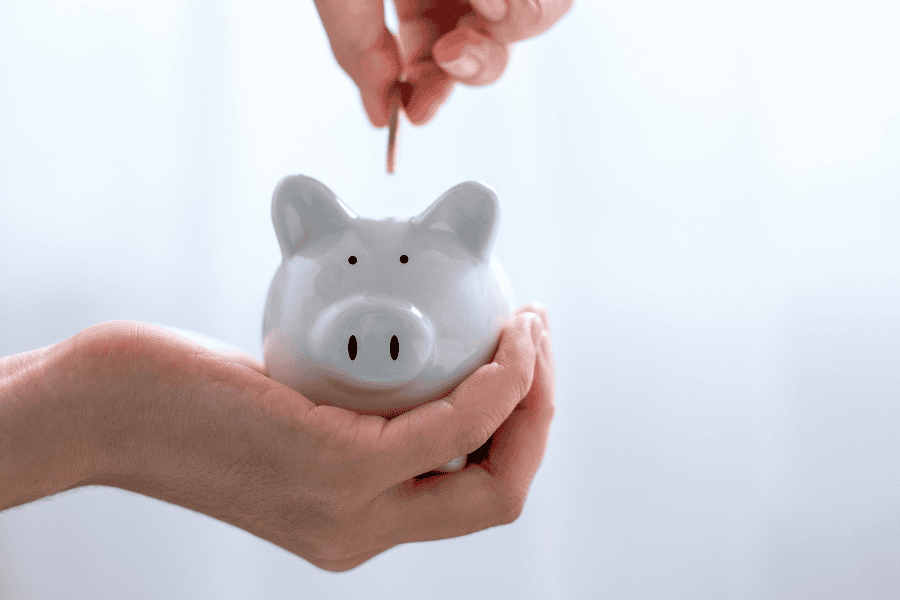Last Updated October 20, 2024 by Davina Kelly
Ever found yourself stressing about unexpected expenses? Like when your car suddenly breaks down? If that sounds familiar, learning how to build an emergency fund can be a game changer for your financial peace of mind.
Building an emergency fund is one of the most important steps in your personal finance journey. It acts as a financial cushion that will help you avoid going into debt when life throws something unexpected your way.
You’ve probably heard people say, “You need to have three to six months of expenses saved up.” But let’s be real – that number can feel like a distant dream for many people. The good news is, you don’t need to reach that target overnight.
In this post, I’ll show you how to build an emergency fund step by step, so you can start small and grow your savings in a way that fits your life.
These are the exact steps I took to build my emergency fund and they work no matter your income level. Even if you’re working with a tight budget, you can still save for a rainy day – trust me, it’s doable.
This post may contain affiliate links, which means we will receive a commission if you purchase through our links, at no extra cost to you. Please read full disclosure for more information.
What is an Emergency Fund and Why Do You Need One?
First things first – what is an emergency fund and why should you care about building one? You might already have a general idea, but let’s break it down and get into the benefits so you can really understand why it’s crucial for your financial stability.
An emergency fund is simply cash set aside for life’s unexpected moments. Think of it as your financial safety net that catches you when life throws those “surprise” expenses your way.
This can include things like a medical emergency, car repair, your boiler breaking down or even job loss. Whatever the case, an emergency fund gives you the cash you need without having to rely on credit cards or loans.
And here’s the important part – your emergency fund isn’t for just anything. It’s for real emergencies, not for planned expenses like vacations or shopping trips. For those, you’d want to use your sinking funds.
Now, I know saving for an emergency fund might seem daunting, especially with the cost of living constantly on the rise. With everything from rent and food costs to clothes and pretty much everything else, prices are going up.
In a world where you can buy anything at the click of a button, it’s easy to feel overwhelmed when it comes to saving. And you’re not alone. In fact, 27% of adults in the U.S. have no emergency savings at all. It’s no wonder so many people are stuck in the cycle of living paycheck to paycheck.
But that’s exactly why building an emergency fund is so important. It can help you break free from that cycle and give you the financial breathing room you need.
Benefits of Having an Emergency Fund
Let’s talk about the benefits. Having an emergency fund offers more than just financial protection – it gives you peace of mind.
When you know you have money set aside for life’s curveballs, you don’t have to stress whenever you hear a funny noise coming from your car or the company announcing layoffs.
Trust me, I know firsthand how much of a difference it makes to have that cushion in place. I’ve been made redundant a few times in my career so I learned the importance of building an emergency fund the hard way.
Other benefits include:
Avoiding debt
When an emergency happens, you won’t have to reach for your credit card and rack up debt to cover costs. This is huge for staying on track with your financial goals.
Financial security
Life is unpredictable. Having an emergency fund for the unexpected makes sure you’re financially secure, no matter what.
Confidence
When you know you’re prepared for the unexpected, you feel more in control of your money and your life. And this feeling is priceless.
How Much Should You Save?
Now, the big question – how much should you save for your emergency fund? The general rule of thumb is to save three to six month’s worth of living expenses.
I know, I know – this sounds like a lot of money. But don’t panic. You don’t need to hit this number all at once.
You can start by saving $1,000, which can help you cover small emergencies like a car repair or medical bill. From there, you can slowly build toward that bigger three to six-month cushion.
How to Build an Emergency Fund Step By Step:
Now you know why an emergency fund is important, let’s talk about how to actually build one. Whether you’re starting from scratch or just need to top up your existing fund, these steps will help you get there.
Step 1. Set a Realistic Starting Goal
One of the biggest mistakes people make is trying to save too much, too fast, and getting discouraged. Instead, start small.
If you’re not used to saving trying to save $10k in a year might be too much. Your first goal could be to save $500 or $1,000. It’s a lot more achievable and gives you a solid cushion for minor emergencies.
Once you hit that milestone, celebrate your win and then aim for the next one – maybe $2,000 or $3,000. The important thing is to create momentum, which makes it easier to stick with your plan.
Step 2. Calculate Your Monthly Essential Expenses
To figure out how much you should aim to save long term, start by calculating your essential monthly expenses.
These are non-negotiable costs like:
- Rent/mortgage
- Groceries
- Utilities (electricity, gas, water, internet)
- Transportation (car payment, gas, or public transit)
- Insurance (health, car, home)
- Minimum debt payments (like credit cards and student loans)
Once you know your money essentials multiply that by 3 to 6 months to set your longer-term savings goal. For example, if your monthly essential expenses are $2,000, you’d aim to save $6,000 to $12,000 for a fully funded emergency fund.
But again, don’t let this number overwhelm you! Focus on reaching your small goals first, then build from there.
Step 3. Review Your Expenses
Reviewing your expenses is arguably one of the most impactful steps in how to build an emergency fund. This is more than just a routine check of your monthly budget.
A full review helps you step back and assess your financial progress, ensuring that you’re moving in the right direction. Your budget is a great tool to help you move forward. But a review is looking at the broader picture to ensure you’re heading where you want to go.
To conduct a full review, start by gathering all your financial information, including bank accounts, credit card statements and spending trackers.
Categorise your spending over the past 6 months to a year. If you have a lot of transactions I suggest reviewing 3 months minimum. While going through your numbers ask yourself three key questions:
Can I eliminate this expense completely?
Can I reduce this expense by using less or finding a cheaper alternative?
Is there a better way to get the same thing at a lower cost?
This process is tedious and it can take a while to complete. However, the return on investment (ROI) makes it worth it. By dedicating this time once or twice a year you can uncover hundreds, if not thousands of dollars in potential savings.

Step 4. Cut Unnecessary Expenses & Plan Ahead to Save
One of the biggest hurdles to saving is impulse spending, especially when you’re stressed or pressed for time. Last-minute decisions often lead to higher costs because you don’t have time to explore better options.
Take food as an example. If you’re busy and haven’t planned your meals it’s easy to fall into the habit of ordering Uber Eats or DoorDash multiple times a week. It may seem convenient, but those small orders can end up costing you hundreds of dollars a month. Trust me, I’ve been there!
To break this bad money habit, try meal prepping. Spend a few hours each week planning your meals and cooking in bulk. It’ll save you money and keep you from reaching for those quick (and expensive) alternatives.
If meal prepping isn’t your thing, I highly recommend the $5 meal plan.
It’s a meal planning service that sends you delicious meals and menus straight to your inbox every week for just $5 a month. Each meal costs only $2 to $3 per person! It’s a great way to save both time and money, without the stress of figuring out dinner last minute.
You can try it completely FREE here for 14 days. If you don’t like it you can cancel at any time with no problems.
Planning ahead helps in other areas of life too:
Transportation: Avoid costly ride-share services like Uber by budgeting your time and taking public transport instead.
Travel: Planning vacations in advance allows you to use reward points for flights and accommodations which will save you a huge amount of money.
Being flexible is important, but consistently relying on last-minute decisions will cost you more over time. Make a habit of thinking ahead and you’ll see the savings quickly add up.
Trim Unnecessary Expenses
If building an emergency fund is a priority (and it should be), trimming your budget is one of the fastest ways to free up extra cash. Here are some simple ways to cut back.
- Cancel unused subscriptions: Do you really need Netflix, Disney + and Amazon Prime Video? Probably not, cancel two and keep one.
- Shop sales: Whether it’s clothes or tech, wait for discounts or use apps to get deals.
- Negotiate your bills: Check price comparison sites to see if you could switch to cheaper service providers.
Every dollar you save can go straight into your emergency fund. Even small changes add up over time!
Step 5. Automate Your Savings
Do you really want to know how to build an emergency fund with ease? Automate the process. It’s one of the easiest ways to fast-track your savings.
Let’s be honest – saving money can feel hard, especially when you have to remember to do it manually each month. So, utilise technology to do it for you.
Set up an automatic transfer from your checking account to a separate savings account right after your paycheck hits. You can start with something manageable like $25, $50 or $100 a month and increase it as your budget allows.
You might be thinking why automation? It’s because it takes the pressure off you to remember and it removes the temptation to spend the money. It’s out of sight, out of mind, but quietly growing in the background.
Another useful feature that many savings apps offer is the “round-up” option. Here’s how it works: every time you make a purchase, the app rounds the amount to the nearest dollar (or pound) and transfers the difference to a savings account.
So, if you spend $1.30 on a coffee, the app will round up the total to $2.00 and deposit the extra $0.70 into your savings.
These may seem like insignificant amounts but trust me, they add up fast. I have this feature enabled on one of my accounts and I easily save an extra $50 – $100 without even trying.
Step 6. Choose the Right Account for Your Emergency Fund
Not all savings accounts are created equal. Your emergency fund should live in an account that’s safe and easy to access but still earns high interest. It’s not just about how to build an emergency fund, it’s also about saving smart.
A high-yield savings account (HYSA) is perfect for this because it offers a higher interest rate than a regular savings account and your money is readily available when you need it.
When choosing your account, look for these features:
- No fees: You don’t want your savings eaten away by unnecessary fees.
- Liquidity: You need to be able to access the money quickly in case of an emergency.
- Separation from your regular checking: Keeping your emergency fund in a separate account helps keep it away until you truly need it.
At the time of writing this, the average savings interest rate is 4%, if your current provider can’t match that, it’s worth checking price comparison sites to find a better deal.
Step 7. Redirect any Extra Cash or Bonuses
Whenever you come into unexpected money – like a tax refund, a bonus from work or birthday cash – put it straight into your emergency fund. It’s money you weren’t counting on, so you won’t miss it and it gives your savings a boost.
I know it might sound crazy right now, especially if you’re used to spending that extra cash on shopping. But once you get into the groove of saving, you’ll actually want to keep going – and trust me, finding ways to redirect extra money into your savings can even become fun.
Even if you have other financial goals like paying off debt, it’s smart to prioritise building up at least a small emergency fund before throwing all your extra cash at loans or credit cards.
Step 8. Track Your Progress
After you’ve implemented these steps, tracking your progress is essential. Learning how to build an emergency fund won’t happen overnight, but by breaking your goal into smaller, manageable chunks and tracking your progress, you’ll stay motivated.
You can grab my FREE emergency fund tracker below. This will help you visualise your progress and stay on top of your goals.
Step 9. Stay Consistent
Building an emergency fund isn’t a one-time event – it’s a long-term habit. The key is consistency. Even if you’re only saving a small amount each month, keep going!
Check your progress regularly and adjust as needed. Got a raise? Great – add a little more to your savings each month.
If you’re worried about losing momentum, set a reminder to check your emergency fund every quarter. This will keep you motivated to stay on track.
How To Build an Emergency Fund on a Low-Income
I know what you’re thinking: “This all sounds great, but what if I’m living paycheck to paycheck?” Trust me, I hear you. Saving money when you’re on a tight budget can feel impossible, but it’s doable with a few creative strategies.
Prioritise Savings (Even If It’s Small)
Even if you’re only able to save $10 or $20 per paycheck, start there. The key is to build the habit of saving. Once you’re in the routine of setting money aside, you can slowly work your way up. Remember, small progress is still progress!
Look for Ways to Lower Expenses
Cutting costs on a low income is challenging, but there are often tweaks that make a big difference. Here are a few ideas:
- Reduce how often you eat out
- Create a grocery budget and shop at cheaper stores
- Use the 48-hour rule to cut down impulse spending
- Look for low-cost alternatives, like hiking or games night with friends instead of pricey activities
Start a Side Hustle for Extra Income
When it comes to saving you can either cut expenses or increase your income. So, if cutting expenses isn’t enough, consider starting a side hustle.
With today’s gig economy, there are plenty of ways to earn extra cash on the side. Whether it’s taking on freelance jobs, selling printables on Etsy, or becoming a virtual assistant, every extra dollar helps.
Add that side hustle income directly into your emergency fund. It’ll grow much faster and since it’s extra money, you won’t miss it.
Related: How To Make $100 a Day (21 Ideas)
When To Use Your Emergency Fund (and When Not To)
Once you’ve built your emergency fund, it’s just as important to know when (and when not) to dip into it.
A true emergency is something unexpected, urgent and necessary. Some examples include:
- Medical bills
- Car repairs
- Job loss
But avoid using your emergency fund for planned expenses like vacations, home renovations, or even a new phone. These are things you should budget for separately.
Rebuilding Your Emergency Fund After You Use It
Life happens, and you might need to dip into your emergency fund at some point. When that happens, don’t panic – just make it a priority to rebuild it. Go back to saving regularly until your fund is back to its original amount.
Maintaining Your Emergency Fund
Once your emergency fund is fully loaded, you might wonder, “Now what?” The key to long-term financial security is maintaining your fund.
Your financial situation can change, so it’s a good idea to review your emergency fund each year. Have your expenses increased? Did you move or take on new financial responsibilities? If so, you may need to adjust your savings target to reflect these changes.
Final Thoughts
Building an emergency fund might feel daunting, but remember – every little bit counts. It’s not about saving thousands of dollars overnight, it’s about taking small, consistent steps to protect yourself from life’s unexpected expenses.
I hope you have found this post helpful and now know how to build an emergency fund. Now, over to you – what’s your first emergency fund goal?
This post was all about how to build an emergency fund.
Other Posts You May Like:
13 Best Money Saving Strategies

Davina Kelly
Hey! I'm Davina, the owner of Davinas Finance Corner. I'm passionate about finding ways to budget, save, earn more money and improve your life. After breaking free from payday loan debt and living paycheck to paycheck I want to share my experience to help other women improve their finances.
